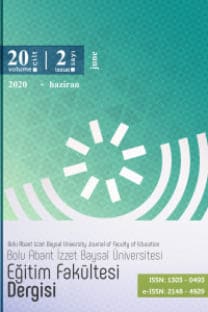Kayıp Veri Ele Alma Yöntemlerinin T-Testi ve ANOVA Parametreleri Üzerine Etkisinin İncelenmesi
Kayıp Veri Analizi, Atama Yöntemleri, BM, Yerine Ortalamayı Koyma, Regresyon
Examining the Effect of Missing Data Handling Methods on the Parameters of t-Test and Anova
Missing Value Analysis, ImputationMethod, EM, MeanSubstitutionMethod, Regression,
___
- Afiffi A. And Elashoff R. M. (1966). Missing observations in multivariate statistics: ı. review of the literature, Journal of the American Statistical Association, 61(315) 595-604.
- Allison P. D. (2001). Missing data, sage university papers series on quantitativ eapplications in the social sciences, ThousandsOaks, CA, Sage.
- Alpar, R. (2003). Uygulamalı çok değişkenli istatistiksel yöntemlere giriş-1, Nobel Kitabevi.
- Bal C. (2003). Çok gruplu veri setlerinde kayıp gözlem sorununun çözümlenmesi ve sağlık alanında bir uygulama, Doktora Tezi,Eskişehir Osmangazi Üniversitesi Sağlık Bilimleri Enstitüsü, Eskişehir.
- Baygül A, (2007). Kayıp veri analizinde sıklıkla kullanılan etkin yöntemlerin değerlendirilmesi, Yüksek Lisans Tezi, İstanbul Üniversitesi Sağlık Bilimleri Enstitüsü, İstanbul.
- Cheema, J. (2012). Handling missing data in educational research using spss. Unpublished doctoral dissertation. George Mason University, USA.
- Çokluk Ö. , Kayrı M., (2011). Kayıp değerlere yaklaşık değer atama yöntemlerinin ölçme araçlarının geçerlik ve güvenirliği üzerindeki etkisi, Kuram ve Uygulamada Eğitim Bilimleri, Kış; 289-309.
- Dempster, A. P.,Laird, N. M, and Rubin, D. (1977). Maximum likelihood estimation from incomplete data via the EM algorithm, JournalRoyal Statistical Soc. 39
- Enders C. K. (2011). Analyzing Longitudinal Data With Missing Values, USA.
- EvensandFiona H. (2003). Detecting fishing underwater video using the EM algorithm, Proceeding of the IEEE International Conference on Image Processing, Barcelona.
- Gildea, L. And Hofmann, T. (1999). Topic-Based language model susing EM, (http://www.cs.brown.edu/people/th/papers/GildeaHofmannEUROSPEECH9 9.pdf , 31. 01. 2013, Erişildi). Iturria, S.J. and Blangero, J. (2000). An EMalgorithmforobtainingmaximumlikelihoodestimatesınthemulti- phenotypevariancecomponents linkage model, Ann. Hum. Genet.,64.
- Kalaycı Ş. (2008), SPSS Uygulamalı Çok Değişkenli İstatistik Teknikleri.
- Karasar N. (2004), Bilimsel araştırma yöntemleri. Ankara : Nobel Yayıncılık.
- Little R. J. A. (1998). A test of missing completely at random for multivariate data with missing values. Journal of the American Statistical Association 38, 1198- 1202.
- Little R. J. A and Rubin D. R.(2002). Statistical Analysis WithMissing Data, Second Edition, Wiley, New York.
- Oğuzlar A. (2001). Alan araştırmalarında kayıp değer problemi ve çözüm önerileri, V. Ulusal Ekonometri ve İstatistik Sempozyumu, Çukurova Üniversitesi İİBF Ekonometri Bölümü, Adana, 19-22 Eylül.
- Rubin, D. R. (1976). Inference and missing data. Biometrika, 63 (3), 581-592.
- Satıcı, E. ve Kadılar, C. (2009), Kayıp gözlem olması durumunda kitle ortalamasının tahmini, Anadolu Üniversitesi Bilim ve Teknoloji Dergisi, 10(2), 549-556.
- Sezgin E. ve Çelik Y.(2013). Veri madenciliğinde kayıp veriler için kullanılan yöntemlerin karşılaştırılması, Akademik Bilişim Konferansı, Akdeniz Üniversitesi, 23-25 Ocak 2013.
- Tabachnick, B. G. and Fidel (2001). L.S. Using multivariate statistics (4th ed.). Needham Heights, MA: Allyn& Bacon.
- Yazıcıoğlu, Y. ve Erdoğan, S. (2007). Spss uygulamalı bilimsel araştırma yöntemleri. Ankara: Detay Yayıncılık.
- Yazıcı, F. (2005). EM algoritması ve uzantıları, Yüksek Lisans Tezi, Hacettepe Üniversitesi Fen Bilimleri Enstitüsü,Ankara.
- Yozgatligil, C., Purutcuoglu, V., Yazıcı, C. ve Batmaz, İ. (2011). Validity of homogeneity tests for meteorological time series data: a simulation study. "Proceedings of the 58th World Statistics Congress (ISI2011)".
- ISSN: 1303-0493
- Yayın Aralığı: 4
- Başlangıç: 2000
- Yayıncı: Abant İzzet Baysal Üniversitesi Eğitim Fakültesi
Okul öncesi ve sınıf öğretmenlerinin 60-72 aylık çocukların okula hazır bulunuşluklarına
Ayşe Nur CANBULAT KUTLUCA, Füsun YILDIZBAŞ
İlker KÖSTERELİOĞLU, Raşit ÖZEN
GRAFİK DÜZENLEYİCİLER VE ORTAÖĞRETİM FİZİK DERS KİTAPLARINDA KULLANIMLARININ İNCELENMESİ
Canan NAKİBOĞLU, Merve ÇAMURCU
Süreç temelli yaratıcı yazma uygulamalarının yazılı anlatıma ve yazmaya ilişkin tutuma etkisi
Hülya GÜLAY OGELMAN, Zeynep ÇİFTÇİ TOPALOĞLU
Sanat Eğitiminde Müzelerin Eğitimsel Rolleri ve İşlevleri
Kayıp Veri Ele Alma Yöntemlerinin T-Testi ve ANOVA Parametreleri Üzerine Etkisinin İncelenmesi
İbrahim Alper KÖSE, Begüm ÖZTEMUR
YARATICILIĞA TEŞVİK EDİCİ ÖĞRETMEN DAVRANIŞLARI İNDEKSİ’NİN (YÖDİndeksi) TÜRKÇEYE UYARLANMASI
Fen Bilgisi Öğretmen Adaylarının Teknolojiye İlişkin Görüşleri
